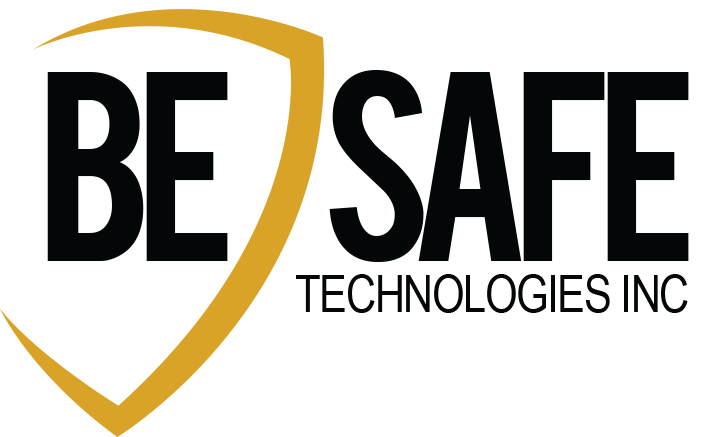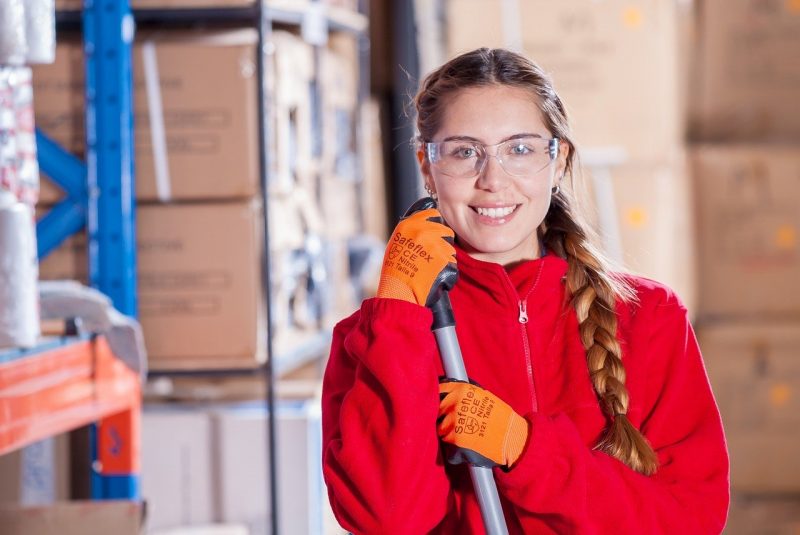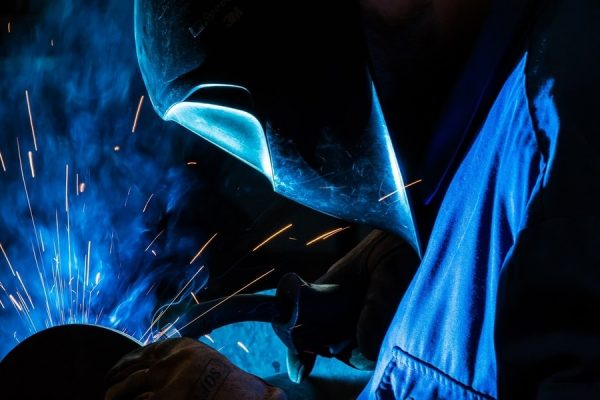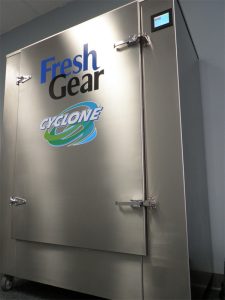Our eyes are one of the most important organs of the body. Unfortunately, they’re also one of the most delicate and susceptible to injury. Let’s face it, they’re a wee bit squishy. Safety glasses and goggles go a long way in protecting our eyes from excessive light stimulation, UV rays, and foreign objects.
Doing activities like welding, construction, or motorcycle riding without proper eye wear can have devastating long term effects on our vision. Proper eye protection is the best way to avoid injury. And when it comes to the workplace, eye protection not only benefits employees, but also the company’s bottom line.
Today’s article will explore the importance of safety glasses and goggles, especially in the workplace.

Why Wear Safety Glasses and Goggles?
Eye injuries are more common than most people realize.
According to ISHN (Industrial Safety & Hygiene News), 300,000 eye injuries in the workplace send people to the hospital every year nationwide. In most of those cases, safety eyewear is not being worn, it doesn’t fit, or doesn’t provide the appropriate protection for the application.
In fact, of these 300,000 eye injuries, it’s estimated that 90% of them were preventable if the workers had been wearing appropriate eye protection.
The Cost of Eye Injuries
The economic cost, not to mention the human cost of pain and suffering, is astronomical. In fact, the Occupational Health and Safety Administration (OHSA) reports that the economic cost to employers and employees is in the billions.
These figures are staggering on their own. However, these figures only account for workplace related eye injuries. When workplace eye injuries are factored in, the numbers are still shocking.
It’s estimated that eye injuries on the job account for nearly $300,000,000 yearly. That includes insurance payments, medical costs and lost production. These dollars are coming out of the pockets of both employee and employer.
Eye Injuries May Cause Blindness
Another thing most people don’t realize is that eye injuries are a leading cause of preventable blindness in America. A significant percentage of eye injuries result in long term vision loss.
However, eye injuries are largely preventable with proper safety glasses and goggles. 65% of eye injuries in the home happen while not wearing safety eyewear, and 60% of all eye injuries that happen at work happen while the eyes are unprotected.
At best, eyewear can prevent injuries. At worst, safety glasses and goggles can lessen the extent of the injury to prevent permanent blindness.
Considering all these facts, why don’t people just protect their eyes?
Unfortunately, it is often the case that facts and words don’t teach. Experience teaches. And sometimes people only learn when they learn the hard way.
But perhaps with a little forethought, we can protect ourselves from potential disaster. So with that in mind, let’s hear Max’s story.
The Importance of Safety Glasses and Goggles: Max’s Story
Meet Max.
Max is a regular everyday guy. He is 18 years old and leaving home for the first time.
Max is going off to college to become a paramedic. Being a paramedic is what he has always wanted, and he is so excited to finally learn how to be a hero.
 Most Workers Get Trained to Use Personal Protective Equipment
Most Workers Get Trained to Use Personal Protective Equipment
On his first day of classes, Max is taught about the importance of using personal protective equipment. He is taught how to put on a gown, gloves and eyewear each time he comes in contact with a patient. He buys himself fancy new equipment and studies hard to pass his classes.
On each practical exam, Max is awarded full marks for diligently remembering to wear his personal protective equipment. Eventually, he’s successful in school and finds his way to the ambulance.
On his first day on the ambulance, he encounters Tim. Tim is a senior paramedic. As is the tradition on paramedic services, Tim and his buddies like to tease Max for being “fresh blood”. They always tease the new people for being so particular about every little thing, especially how obsessive they are about safety.
Bad Habits Develop Over Time
It doesn’t take Tim long to start teasing Max about his habit of wearing too much personal protective equipment. At first, Max thinks Tim is joking, but overtime he realizes that Tim is serious. Tim doesn’t seem to wear his glasses or gown at all. In fact, most times, he simply puts on a pair of gloves, even if a patient looks really sick.
One day, Max and Tim get a call on the radio. The dispatcher describes a situation where two men seem to have gotten in a fight at a bar. Max and Tim have been to this bar before, many times. Every time they get called to this bar they end up issuing ice packs and giving out band aids – nothing too serious.
However, every time they go to this bar, Tim teases Max for being uncomfortable and “over-dressing”. Max was taught that anytime there is a traumatic incident, a paramedic should wear their protective equipment, because you never know what to expect. But Tim thinks he’s seen it all and nothing can happen to him.
It Only Takes Once
This time, tired of the teasing – and quite sure of what they are going to find at the bar – Max decides to only wear his gloves. “That ought to shut him up”, Max thinks.
When they arrive, they find three men who were obviously in a brawl. One of them has vomit on his shirt, the other is very badly bleeding from his leg. He sees a bloody broken beer bottle on the floor next to the man with the injured leg.
Max’s training immediately takes over and he rushes to put pressure on the bleeding leg. In the process, blood gets all over his face and shirt. Tim and Max quickly bandage up the three men and bring the one with the injured leg to the hospital.
After they drop him off, Tim reminds Max that he has blood all over him. Max needs to go get cleaned up and checked out.
As is the procedure, they flush Max’s eyes with water, bathe him off, and do a blood test to see if he was exposed to anything from the patient’s blood. The nurse asks him if the blood made direct contact with his inner body (eyes, mouth, open wounds, etc.). He realizes that he wasn’t wearing his glasses, and yes, blood got in his eyes.
2 weeks later, Max receives notice that he has contracted Hepatitis C. He will have to be removed from active duty until he is fit to return to work. Eventually, Max is told that his immune system has not recovered, and he will be unable to return to work. Devastated, Max has to give up his dream of being a paramedic.
Lessons From Max’s Story: Protect Yourself
Max was lucky that the damage to his eyes and overall health wasn’t worse. Many workers don’t get as lucky as Max. For example, if a construction worker doesn’t use his glasses even once, he could be facing permanent blindness if there was an accident.
Unfortunately, Max’s story is a common one. The OSHA has put regulations in effect to make sure employers equip employees with all the necessary safety equipment they require, including eyewear. They have also made it mandatory to train workers on safety in their workplace, and the OSHA does their best to enforce these regulations to make sure everyone plays their role.
Where things go wrong is when workers develop bad habits. They become compliant and stop taking common-sense measures to protect themselves. That’s when they become especially vulnerable to injury.
When To Wear Safety Glasses and Goggles
Everyone has a role to play in safety. The people with arguably the biggest role to play are the workers performing the activity. Play your part to make sure you stay safe by making sure you chose the right eyewear for the job.
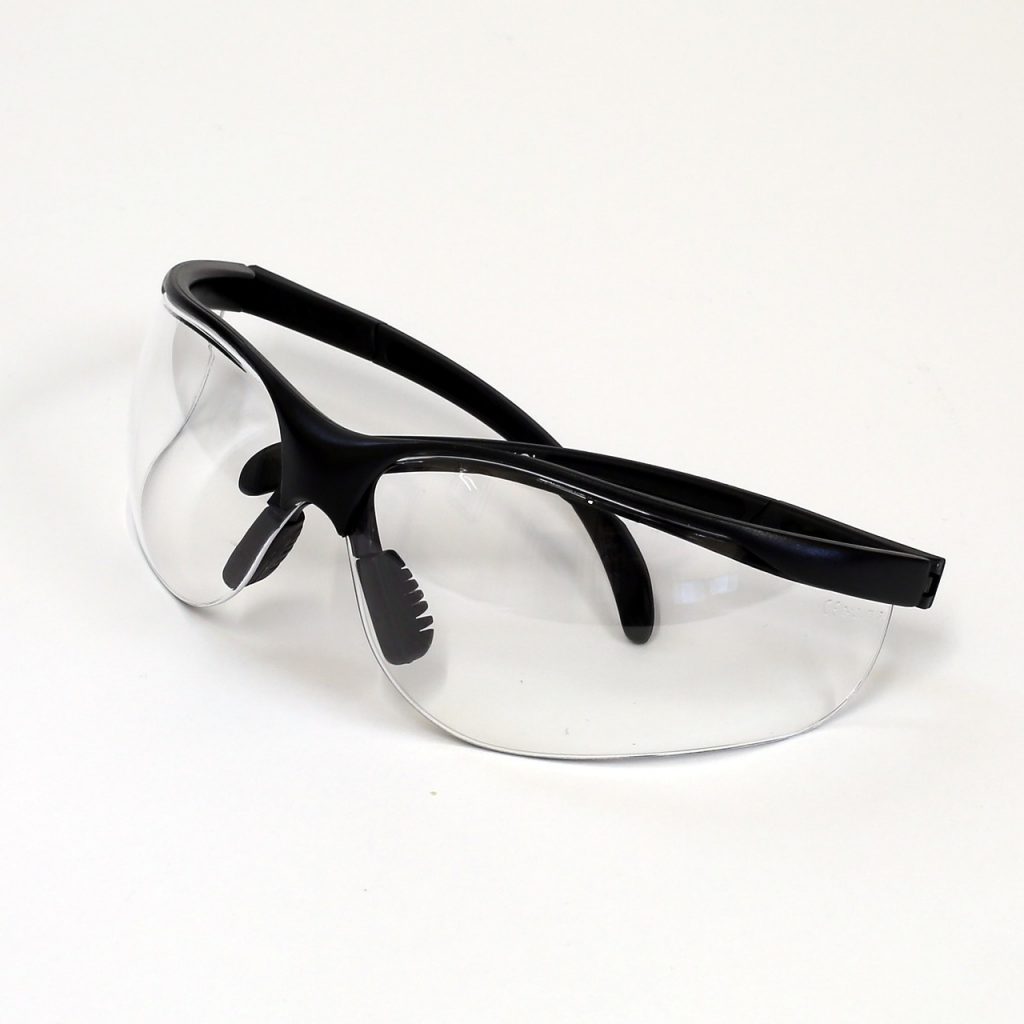 Safety Glasses
Safety Glasses
Safety glasses are the appropriate eyewear to choose when an activity requires impact protection. They offer impact resistance against projectiles and are usually more comfortable than goggles, as they allow for ventilation of the eyes.
Safety glasses have impact resistant frames, and often have wrap around shields around the sides. They can also be tinted to allow for protection from certain types of light exposure. In the majority of cases requiring eye protection, safety glasses are a good choice.
Polycarbonate safety glasses are the best choice for impact resistance, as polycarbonate is up to 10 times as impact resistant as other materials.
 Safety Goggles
Safety Goggles
The major downside of safety glasses is that they allow space for material to travel under or over the glasses and contact the eyes. In situations where the main threat is exposure to an irritant rather than a flying object, it is best to choose safety goggles.
Choose safety goggles when you may be exposed to the following:
- Splashing liquids: which may be found in medical, chemical, or cleaning industrial applications
- Airborne dust particles: such as when sawing or doing other construction work
- Caustic vapors: such as when working in certain hazardous environments, like laboratories
Choosing the right type of protection appropriate for the activity is necessary to receive adequate protection.
Highest Risk Activities At Work, Home, and Play
Different workplace, home, and leisure activities pose different types of risk to the eyes. Here are the highest risk activities in each category.
Highest Risk Workplaces
Trade workers suffer the most workplace eye injuries of any type of worker. Over 40% of workplace eye injuries happen to craft workers, including carpenters, mechanics, plumbers, repairers and more. People who work in these environments should be especially cautious to prevent eye injury.
Specifically, high-risk groups include the following, with the percent of all workplace eye injuries that occur while performing that activity
given after the group:
 Laborers and freight, stock and material movers, 7%
Laborers and freight, stock and material movers, 7%- Welders, cutters, solderers, and brazers, 7%
- Production workers, 4%
- Construction laborers, 4%
- Maintenance and repair workers, 4%
- Automotive service technicians and mechanics, 4%
- Truck drivers (heavy and tractor trailer), 3%
- Janitors and cleaners, 3%
- Carpenters, 3%
- Plumbers, pipefitters and steamfitters, 3%
- Assemblers and fabricators, 2%
- Electricians, 1%
The BLS also states that 30% of all workplace eye injuries occur because of flying objects, like falling equipment. That means that around 30% of injuries can be avoided by using safety glasses.
Another 40% percent of all workplace eye injuries happened because of foreign matter in the eye, or exposure to some kind of toxic substance. These types of injury could be avoided by wearing appropriate safety goggles, which don’t allow foreign matter to contact the eye.
Finally, 5% of eye injuries occurred because of flash burn injuries from welding. Wearing appropriately tinted eyewear can prevent these types of burn injuries.
Injury Prone Activities At Home
Outside the workplace, people are prone to injure themselves while completing chores or activities around the home. At home, it’s easy to let safety standards slip because no one is watching.
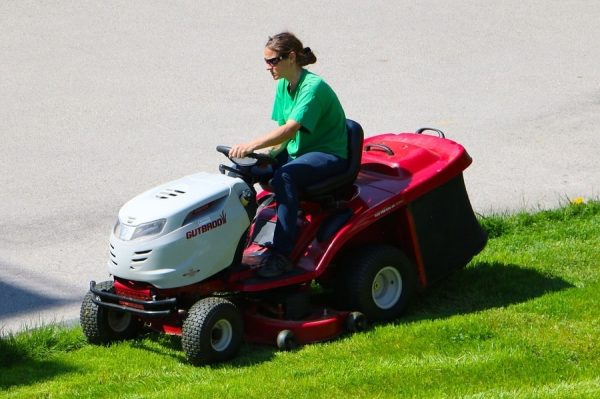 However, the AAO suggests that slipping on a pair of safety googles or glasses should be as common as using a seatbelt. They recommend that every household should have at least one pair of approved safety glasses or goggle for use with the following common household activities:
However, the AAO suggests that slipping on a pair of safety googles or glasses should be as common as using a seatbelt. They recommend that every household should have at least one pair of approved safety glasses or goggle for use with the following common household activities:
- Home repairs: Items like nails, screws, and hand tools can become projectiles, while power tools can make all kinds of debris airborne.
- Yard work: Common items like lawn mowers, trimmers, hoes and shovels can cause irritating substances to become airborne. Twigs, thorns, and other yard material can also find its way to the eye.
- Cleaning: Chemicals like bleach in household cleaning products cause 125,000 eye injuries each year.
Don’t underestimate the danger posed by common household activities. The AAO estimates that 40% eye injuries happen at home.
Highest Risk Recreational Activities
Finally, make sure to seek proper eye protection during recreational activities.
Basketball is the number one cause of sport related eye injuries among adults over 15 years old, while baseball is the biggest culprit among those under 15 years old. Other sports like hockey, squash, racquetball, and martial arts pose a serious risk of eye injury as well and should be prevented appropriately.
Outside of sports, playing with sparklers or fireworks accounts for a large share of eye injuries. Flying bursts from fireworks, or flames from a sparkler can burn the eye or cause permanent damage if it makes direct contact with the eye. Always observe safety instructions to stay the required distance back and consider using safety eyewear on young children observing homemade fireworks.
Additional Situations Requiring Safety Glasses and Goggles
Long term eye health can seriously be affected by many common situations, which people tend to overlook. Here are some of those common risks, and how to avoid them:
- The Sun: The sun emits harmful ultraviolet rays that can damage receptors in the eyes. Long term exposure to these rays can be very detrimental. Sunglasses with proper UVA and UVB protection are recommended to prevent long term damage.
- Digital Screens: Digital screens emit blue light, which, over time can contribute to digital eye strain, or computer vision syndrome. Blue-light blocking safety glasses can cut glare, limit blue light exposure, and help prevent these conditions from developing. These may be beneficial for office workers.
Additionally, most phones and tablets now have built in blue-light filters that you can activate with a tap of the finger.
- Low Light Conditions: Copper, orange, or yellow tinted glasses can help to increase contrast in low light conditions, helping to improve the vision of people with eye diseases. These glasses can also help those who suffer from bipolar disorder or sleep problems, as they help to regulate excessive blue light exposure.
Tinted, protective safety glasses should be considered in these situations to prevent injury to the photosensitive part of the eyes.
Preparation is the Best Form of Prevention
When it comes to the eyes, there is no better way of preventing health problems than by using appropriate safety glasses and goggles. The sad reality is that eye injuries are a leading cause of blindness in America, yet, they are largely preventable with a simple choice to use safety eyewear.
Unfortunately, too many people choose not to think about unpleasant things happening to them. They fail to prepare themselves for harsh situations, thereby missing out on the opportunity to act while they can. Whether it’s protecting your eyes or protecting your organization, it’s critical to think ahead.
BeSafe Technologies offers a school and workplace safety system that facilitates the sharing of information among all necessary parties during an emergency. This cutting-edge platform helps to save lives by disseminating critical information to first responders in real time, as well as keeping administrators and management abreast of events as they occur.
If you’re interested in taking proactive steps to protect the people in your organization, contact us today. Join the mission to save lives and keep communities safe.
